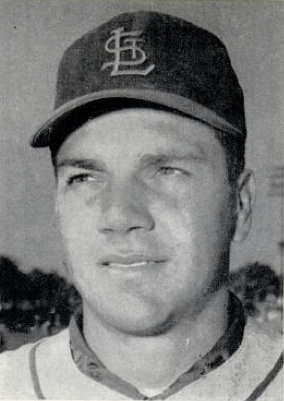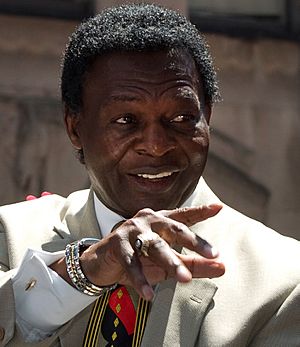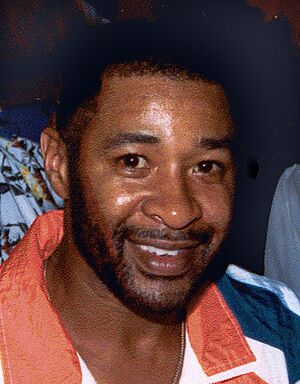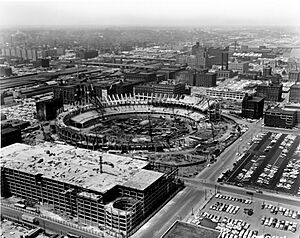History of the St. Louis Cardinals (1953–1989) facts for kids
| St. Louis Cardinals |
|
History
People
Overview
Grounds
Teams
|
The St. Louis Cardinals are a professional baseball team based in St. Louis, Missouri. They play in the National League (NL), which is part of Major League Baseball (MLB).
In 1953, a large company called Anheuser-Busch (AB) bought the Cardinals. Gussie Busch became the team president. His influence is still seen today, as three of the Cardinals' home stadiums have been named some form of Busch Stadium. The team won three World Series titles in the 1960s and 1980s. They were generally competitive, not finishing last until 1990, which was the first time since 1918. During Busch's time as owner, the Cardinals also won six NL pennants.
Contents
A New Era for the Cardinals (1953–1963)
Soon after Anheuser-Busch bought the team, Gussie Busch also bought Sportsman's Park. This was the stadium where the Cardinals played. He fixed it up and renamed it Busch Stadium. Another St. Louis team, the Browns, had not been very successful. They couldn't compete with the Cardinals, who now had a wealthy owner. After the 1953 season, the Browns left St. Louis to become the Baltimore Orioles. This made the Cardinals the only major league team in St. Louis.
Breaking Barriers in Baseball
Baseball began to break its "color barrier" in 1947, allowing African-American players. In 1954, the Cardinals welcomed their first African-American player, Tom Alston. This was an important step for the team. Gussie Busch, the team president, wanted the Cardinals to be a team for everyone. He believed that baseball should be open to all players.
Alston didn't stay with the Cardinals for long. However, other talented black players soon joined the team. These players included Bob Gibson, Lou Brock, and Curt Flood. They helped the Cardinals become very competitive in the 1960s. The Cardinals also became the first Major League team to have integrated spring training housing. This meant all players, regardless of race, stayed in the same places during training.
Early Seasons and New Stars
Between 1954 and 1959, the Cardinals had some ups and downs. They finished with a losing record in four out of five seasons. In 1954, Wally Moon joined the team. He played center field and won the first Rookie of the Year award in team history. He had a great batting average of .304.
The next season, Bill Virdon replaced Moon in center field and also won the Rookie of the Year award. In 1957, the Cardinals finished in second place in the league. They were excellent at batting, leading the league with a .274 average.
Football Cardinals Move to St. Louis
In 1960, a National Football League (NFL) team also called the Cardinals moved to St. Louis. They came from Chicago, where they couldn't compete with the more popular Chicago Bears. The football Cardinals played in St. Louis at Busch Stadium until 1987. After that, they moved to Phoenix and became the Arizona Cardinals.
For many years, local fans called the baseball team the "baseball Cardinals" or "Redbirds." The football team was known as the "football Cardinals" or "Gridbirds."
Stan Musial's Amazing Career
Stan Musial was the Cardinals' most consistent player during this time. He won seven batting titles. He was also chosen for the Major League Baseball All-Star Game every year from 1946 until he retired in 1963. In 1958, Musial became only the eighth player in MLB history to get 3,000 hits.
In 1968, the Cardinals put up a statue of Musial outside their stadium. It was moved to the new Busch Stadium in 2006. The statue has a famous quote: "Here stands baseball's perfect warrior. Here stands baseball's perfect knight." In 2011, President Barack Obama gave Musial the Presidential Medal of Freedom. This is a very high honor for civilians.
Champions in the 1960s (1964–1969)
The Cardinals became a top team again in the 1960s. This was thanks to a big trade and a fantastic pitcher.
The "Brock for Broglio" Trade

In 1964, the Cardinals made a trade with their rivals, the Chicago Cubs. They traded pitcher Ernie Broglio and two other players for outfielder Lou Brock and two others. This trade became famous as "Brock for Broglio." It's known as one of the most one-sided trades in baseball history. The Cardinals gained a lot from it. Brock took over in left field after Stan Musial retired.
Later that season, the team had some drama. Gussie Busch, the owner, was unhappy that the team wasn't catching up to the Philadelphia Phillies. He fired the general manager, Bing Devine. Busch also thought about firing manager Johnny Keane. But he secretly met with another manager, Leo Durocher, to offer him the job for the next season. When Keane found out, he was upset.
Even with the drama, the Cardinals played great. Led by Brock, MVP third baseman Ken Boyer, and pitcher Bob Gibson, they caught the Phillies. The Phillies had a big lead, but the Cardinals won the league pennant. Then, the Cardinals beat the New York Yankees in the 1964 World Series. Gibson was named the series MVP. After the World Series win, Busch changed his mind about firing Keane. But Keane was still upset and took a job with the Yankees. Red Schoendienst became the new manager.
New Stadium and Gibson's Amazing Year
In 1966, the Cardinals moved into their new home, Busch Memorial Stadium. They also hosted the MLB All-Star Game that summer. The next year, led by MVP Orlando Cepeda, St. Louis won 101 regular season games. They went on to win the league and the 1967 World Series against the Red Sox. Bob Gibson was incredible, pitching three complete-game wins and allowing only three earned runs. He was named World Series MVP for the second time.
The 1968 season was known as the "Year of the Pitcher." Pitchers dominated hitters across all of baseball. Gibson was the best of them all. His earned run average (ERA) was an amazing 1.12. This is a record for the modern era of baseball. He won both the NL Cy Young Award and the NL MVP Award. The Cardinals' pitching staff had the best ERA in MLB at 2.49. They faced the Detroit Tigers in the 1968 World Series. Gibson again pitched three complete games and set a World Series record with 35 strikeouts. He even had 17 strikeouts in Game 1. But the Cardinals lost the final Game 7.
After the 1968 season, Major League Baseball changed its structure. Both the National and American Leagues were split into "East" and "West" divisions. The Cardinals were placed in the National League East division. This helped keep their strong rivalry with the Chicago Cubs going.
Competitive Years in the 1970s

The Cardinals remained a good team in the 1970s. Their best season was 1971, when they won 90 games and finished second in their division. They also finished second in 1973 and 1974. They had a winning record six times during the decade.
The 1970s also saw some important moments related to player rights. Before the 1970 season, player Curt Flood refused a trade to Philadelphia. He challenged a rule called the "reserve clause," which tied players to one team. His actions helped lead to players gaining "free agency." This means players can choose which team to play for after their contract ends.
Another big trade happened when pitcher Steve Carlton was traded to the Phillies. This trade also turned out to be very one-sided, but this time it hurt the Cardinals. Carlton went on to lead the Phillies to three division titles.
Star Players of the 70s
Bob Gibson won his second Cy Young Award in 1970. Joe Torre and Keith Hernández each won an NL MVP Award in 1971 and 1979. Ted Simmons became one of the best hitting catchers in team history. He batted .298 and was an All-Star six times.
Gibson retired as the Cardinals' all-time leader in wins (251), strikeouts (3117), and shutouts (56). Lou Brock set a modern-day record for stolen bases with 118 in 1974. Only Rickey Henderson has stolen more bases in a single season since then. Brock is also second all-time in career stolen bases with 938. He got his 3,000th hit in 1979. Brock is the Cardinals' team leader in stolen bases (888) and second in hits (2,713) and runs scored (1427).
The "Runnin' Redbirds" (1980s)

In 1980, the Cardinals hired Whitey Herzog as their manager. He became famous for a style of play called "Whiteyball." This style used the special Astroturf field at Busch Memorial Stadium to its advantage. Herzog's team focused on speed, strong defense, and good pitching.
His strategy involved players who could hit line drives that would bounce high on the Astroturf. They also focused on getting on base, stealing bases, and using plays like the hit and run. This was a way of playing "small ball" but on a bigger scale. Key players in this style included outfielders Lonnie Smith, Willie McGee (who won two batting titles), Andy Van Slyke, and Vince Coleman. Infielders like Ozzie Smith were also crucial.
Herzog was one of the most successful managers in team history. His Cardinals teams won the league three times and the World Series once.
Almost Champions (1980–81)
The 1980 team had one of the best offenses in the league. They led the NL in many batting categories, including runs scored and batting average. Six players hit over .300. The 1980 Cardinals set a record by having five players win the Silver Slugger Award in its first year. These players were Keith Hernández, Garry Templeton, George Hendrick, Ted Simmons, and Bob Forsch. However, their pitching was not as strong, and they finished last in that area.
St. Louis started winning again in 1981. But they missed the playoffs because of a strike-shortened season. Even though they had the best overall record in their division, a special playoff format that year meant they finished second in both halves of the season.
Between 1981 and 1984, pitcher Bruce Sutter saved 132 games. He was one of the best relief pitchers in baseball. Bob Forsch, John Tudor, and Joaquín Andújar were important starting pitchers. Joaquín won 20 or more games in both 1984 and 1985.
The Peak of Whiteyball (1982–1987)
Another major trade changed the team's path, just like in 1964. Before the 1982 season, the Cardinals traded shortstop Garry Templeton for Ozzie Smith from the San Diego Padres. Ozzie Smith was perfect for the "Whiteyball" style of play. He was nicknamed "The Wizard" because of his amazing defense. He won thirteen Gold Gloves.
The Cardinals went on to win the 1982 World Series against the Milwaukee Brewers. Catcher Darrell Porter was named MVP of both the NLCS and the World Series for his excellent hitting.
On September 26, 1983, Bob Forsch pitched his second career no-hitter as a Cardinal. He is the only player in team history to do this. That season, the Cardinals set a team record with 207 stolen bases. The next season, they broke that record again with 220 stolen bases. They were also the first team since 1916 to have 200 or more stolen bases for three years in a row.
The "I-70 Series" (1985)
In 1985, the Cardinals played their cross-state rivals, the Kansas City Royals, for the first time in a major series. The Cardinals won 101 regular-season games and the league. Willie McGee had an MVP season, leading the league in batting average (.353), triples (18), and hits (216). Pitcher John Tudor won 21 games and had 10 shutouts.
Rookie Vince Coleman added even more speed to the team. He stole a major-league leading 110 bases, setting a new team record of 314 stolen bases for the season. After beating the Los Angeles Dodgers in the 1985 NLCS, the Cardinals reached the World Series to face the Royals. The series was called the "I-70 Series" because the highway connects the two cities.
The Royals won the series in seven games. However, a famous bad call by umpire Don Denkinger in Game 6 was very important. In the 9th inning, the Cardinals were leading 1–0 and were close to winning the Series. Denkinger's call at first base helped the Royals start a comeback. The Royals won that game 2–1 and then won the deciding Game 7.
League Champions Again (1987)

In 1987, manager Whitey Herzog put Willie McGee in an unusual spot in the batting order, as the number-five hitter. McGee responded well, getting 105 RBIs even with only 11 home runs. Vince Coleman became the first player to steal 100 or more bases in each of his first three seasons in the major leagues.
The Cardinals reached the 1987 World Series, but lost to the Minnesota Twins in seven games. Key players like Jack Clark and Terry Pendleton were injured. This made it hard for St. Louis to keep up with the Twins' strong offense. This series was the first World Series where the home team won every game. It happened again four years later with the Twins.
In 1989, Vince Coleman set another stolen base record. He stole 50 bases in a row without being caught. Pedro Guerrero led the team with a .311 batting average and 117 RBIs. That year, the team set a new attendance record, with over 3 million fans coming to games.
In September 1989, Gussie Busch passed away. He had owned the team for 37 years, the longest ownership in team history. The Anheuser-Busch company took over the team. However, the Cardinals' success began to slow down until the company sold the team in 1995.
Whitey Herzog continued managing the Cardinals until he suddenly resigned less than a year after Busch's death. Besides winning a World Series title and three NL pennants, Herzog also won the 1985 NL Manager of the Year award. He led the Cardinals to 822 regular season wins.
Franchise timeline
For the next historic period, see: 1990–present.
1875–1919 | 1920–1952 | 1953–1989 | 1990–present
|



